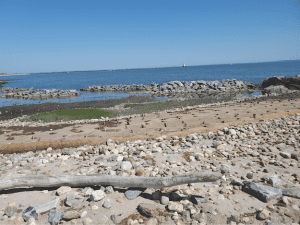
The Hepburn Preserve is a 4-acre beach, dune and brackish tidal wetland habitat owned by the Lynde Point Land Trust, located in the Borough of Fenwick in Old Saybrook. Storm events have caused serious erosion of the area when strong winds and waves hit the shoreline, compounded by shoreline changes due to nearby seawalls and groins. Several major coastal storms overtopped or breached the dunes including Tropical Storm Irene in 2011 and Superstorm Sandy in 2012. A permanent breach, compounded by sea level rise, would cause long term changes to this marsh system.
As a solution, an innovative hybrid living shoreline was proposed, designed and implemented at the site to decrease erosion of the beach/dune habitat, create marsh habitat along the shoreline, and aid in the protection of the dune system. Living shorelines are a green infrastructure technique to aid in shoreline stabilization using native marsh vegetation. Sometimes low sills (such as rock or oyster reefs) are incorporated into living shoreline designs, hence the term, “hybrid” living shoreline. The purpose of a sill is to break and slow wave energy. Sills are placed parallel to the shoreline with the length and height dependent on site requirements. When multiple sills are used, large enough spaces between sills is required to allow for movement of marine organisms.
This project supports the “It Takes a Village” theme. The land trust, Borough of Fenwick officials and local residents had started to meet years before this living shoreline was implemented to educate each other and to research and discuss various options. They spoke with many different groups, including Connecticut Sea Grant/UConn Extension, on how they might best proceed and what their options for a living shoreline might be. Many partners were brought together with the Connecticut River Conservancy taking the lead on a Long Island Sound Study Futures Fund grant that funded part of the implementation. Visit climate.uconn.edu for more information.
Article by Juliana Barrett